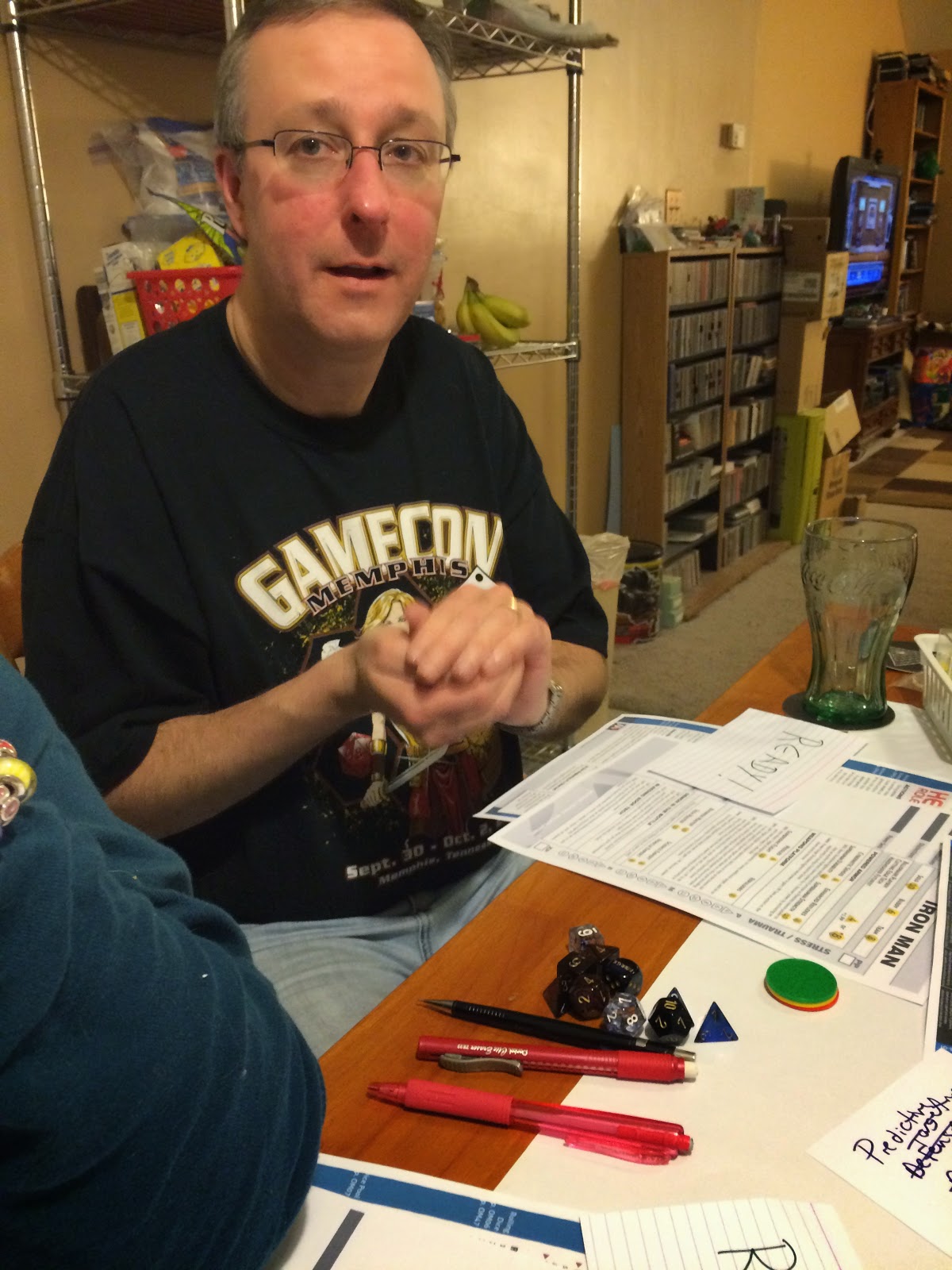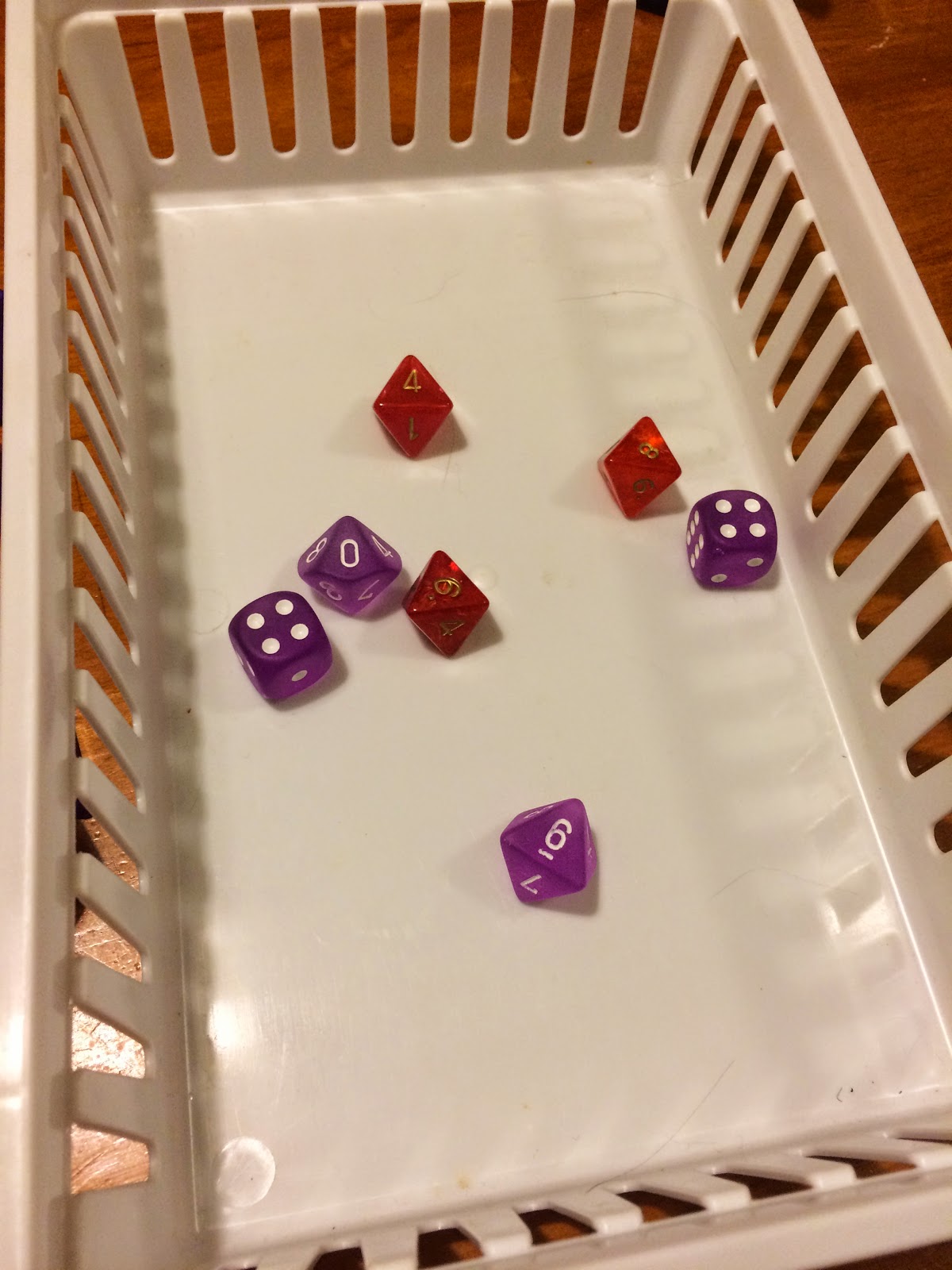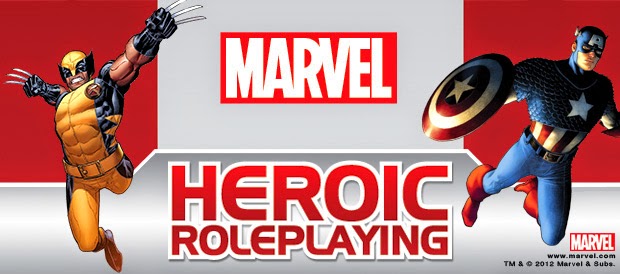I ran a one-shot adventure of Marvel Heroic Roleplaying Friday night, both to get more familiar with the system and to, I hope, jump-start a new game night. I’ve only played the game once, and hadn’t run it myself till this occasion. But I’ve read the rule book three times—to prepare to run games that never materialized—and I find the system really unique and appealing.
Four players joined me for the game, only one of which had also played before. They were:
- Jeff, playing Iron Man
- Shannon, playing Spider-Woman
- John, playing Daredevil
- Kelly, playing Ms. Marvel
If you’re like me in thinking “One of these things is not like the other,” I’d like to mention that it impressed me how the Marvel system easily handles a group of heroes of what we’d normally think of as differing power levels; in a point-buy system, a street-level fisticuffs-based hero like Daredevil would be much less powerful than a cosmic-level hero like Ms. Marvel. But in this game, the two PCs playing those characters were able to take similar actions and it never seemed like one was less capable than the other.
DoomOS
The Event I ran (that’s what MHR calls adventures) was one I wrote for the occasion, called “DoomOS.” The heroes received a video distress call on their Avengers communicators. (By coincidence all the PCs were either current or former Avengers, so the players reasoned that this would be a good way to receive their mission trigger.) The call was from Willie Lumpkin, the mailman to the Fantastic Four.
“Thank God I reached you! Please help! The Fantastic Four are in trouble. The Baxter Building is under attack by…oh no!” The signal cut off.
The heroes didn’t see anything amiss when they reached the Baxter Building, so they opted to enter the building via the standard lobby entrance instead of the roof (or smashing through a wall). They learned a few things from the receptionist: the Fantastic Four aren’t answering their phone (a special blue one set aside specifically for calling them); only the FF can grant access to their suites (on the top 5 floors); and Willie Lumpkin was last seen heading up to visit the FF to deliver today’s mail and packages.
Iron Man tried to wirelessly hack the FF’s computer system, but failed. This surprised Iron Man, because he was certain that he was smarter than Reed Richards and could easily hack his systems. Iron Man did, however, manage to gain access to the restricted elevator to the FF suites. The heroes headed upstairs.
(GM note: I figured the PCs would try to hack the computers, but didn’t want them to succeed at that yet because that’s what ending the adventure would depend upon. So I was happy that Jeff rolled poorly against the Doom Pool–but I wanted to reward his smart thinking, so I granted that Iron Man would still be smart enough to hack the doors. If, instead, he had rolled well, I would have ruled that he successfully hacked the door system but there was some sophisticated foreign code preventing him from gaining further access.)
 |
| Jeff kicked off the Iron Man/Mr. Fantastic rivalry. |
On entering the FF’s reception area on the first of the Fantastic Four’s levels (the 31st floor), the heroes were attacked by the building’s security system, in the form of electrified floors. Only Daredevil was hurt, and from then on all the PCs with flight took care to hover, and all the PCs without flight (Daredevil) stood on furniture or hung from a swingline.
Ms. Marvel set out to search the residential area for signs of life, but was attacked by a stun blaster that dropped down from the ceiling in the hallway. She and the rest of the team destroyed it, and Daredevil used his sonar sense to find two more defensive systems, which the group also destroyed.
Figuring it would be smarter to turn off all the defenses at once instead of fighting them in every room, Daredevil used his sonar sense again to locate the FF’s computer center. Once he got a fix on its location (the 33rd floor) and relayed this to the team, Iron Man blasted a hole in the ceiling and proceeded to the 32nd floor, finding himself in the gym. He figured Reed would forgive the damage, and it wasn’t too bad–the floor was smashed up, but the massive barbells and hydraulic presses that the Thing uses to keep in shape were undamaged.
 |
| The color printout is the Baxter Building. |
Ms. Marvel continued Spider-Woman’s search, locating the Human Torch unconscious on the floor beside his desk. Resisting an attack by gas emitters in the room, Ms. Marvel brought Johnny back to the rest of the group. (I had decided in advance that two of the FF would be on level 31, and that I’d let the players decide which FF members were there as they found them. They picked the Human Torch here, and the Thing later.)
Spider-Woman flew up next and physically smashed through to the target floor, level 33. She made her way through the chemistry lab and past the medical center to the computer complex. There, she found a bank of security monitors that showed where the rest of the FF were: Mr. Fantastic and the Invisible Woman were trapped in a glass chamber in the biology lab (level 33), and the Thing and Willie Lumpkin were snoozing on the floor of the kitchen beside an upended tray of cookies (level 31).
Oh, and she also noticed a large robot looming over her.
(GM note: At this point I realized I’d forgotten that I’d planned on the heroes finding Willie unconscious in the reception area where they first entered the FF suites, so I put him in the kitchen with the Thing instead.)
(Additional GM note: after the heroes discovered the Human Torch and the Thing, I opened them up as playable characters. We thought of a few ways to play this: (a) a player could trade in her current hero and start playing as one of the FF; (b) a player could take on the role of a FF member in addition to his current character; or (c) we could place the FF characters in a pool, and then each turn one player could take an action for one of the FF who hadn’t acted yet in lieu of taking their other character’s action. By this point, I think all the players had settled into their roles and were happy with who they were playing, so nobody controlled Johnny or Ben. I was fine with that, and just wanted to provide it as an option in case any of the players were hard-core FF fans and really wanted to try those roles.)
Spider-Woman saw that the robot was built from a haphazard-looking collection of parts: computer monitors formed the head, roughly-joined computer cases served as arms, and random pieces of doors and other metal odds-and-ends made up the legs. A symbol glowed on each of the two computer monitors that served as giant eyes–an iconized version of Doctor Doom’s mask.
Spider-Woman decided the makeshift Doombot could wait, and concentrated first on shutting down the building’s security system. She was successful, and turned to fight the robot.
(GM note: At this point Spider-Woman also learned that the FF’s computer system, which the players decided normally called itself “FourOS”, was now branding itself as “DoomOS.” She also learned that the system was transmitting a tremendous amount of data to an IP address in Latveria, the country Doctor Doom rules. But I forgot those details at the time she was accessing the computer, so had to slip them in later! I did this by simply telling the players I’d made that mistake, and caught them up on the info they should have had.)
Downstairs, the Human Torch woke up. Ms. Marvel and Daredevil asked him what he remembered. Johnny said he was uploading photos of himself to Facebook, and recalls hearing the doorbell, then loud footsteps that must have been the Thing going to answer the door, then the same footsteps heading back toward the kitchen. Ms. Marvel and Daredevil filled him in on the current situation. Johnny asked Ms. Marvel to help him find his teammates. She agreed, and Daredevil left them to crawl through the ducts to the lab level.
Back in the computer complex, Spider-Woman blasted the Doombot. Wait, that’s not true–her Venom Blast does less damage than her Superhuman Strength, so she punched the bot instead. When it tried to punch back, she tore off its arm. The Doombot didn’t last long after that. While Spider-Woman was cleaning its clock, Iron Man achieved a spectacular feat of hacking and shut down the Internet data feed that was sending FF data to Latveria.
Elsewhere on the same floor, Daredevil located Mr. Fantastic and the Invisible Woman. The chamber holding them turned out to be Reed’s experimental power nullifier. (It was, obviously, functional.) Unfortunately for Daredevil, the chamber blocked all sounds, so he couldn’t hear the captives tell him which of the many nearby buttons would open the nullifier. But Sue had an idea—she tugged up the hem of her pant leg enough to show her green socks, and pointed to them. Daredevil got it, and pushed the green button, releasing the couple. (And now you know, True Believers, that the Invisible Woman wears green socks.)
 |
| Probably these. |
Back downstairs, Ms. Marvel and the Human Torch found the Thing and Willie Lumpkin in the kitchen. Since the security systems that had knocked them out were now disabled, the Thing was already waking up. The heroes helped Willie recover, and the mailman told them his tale: he brought up the mail, and right after the Thing let him in and headed to the kitchen to grab some cookies to share with Willie, one of the parcels flew open and spewed hundreds of tiny metal doohickeys that skedaddled every which way. That’s the last thing he remembered.
Leaving the Torch with Willie, Ms. Marvel followed the Thing as he headed for action, jumping up through the hole in the ceiling leading to the gym. Before our heroine made it through the hole, she saw the Thing punched into the far wall by a second Doombot. Landing in the gym, Ms. Marvel faced off with a Doombot with dumbbells for arms and hydraulic presses for legs.
“Kneel before Doom!” the cobbled-together Doombot said.
Ms. Marvel declined, deciding instead to blast the bot. Her first shot dealt serious damage. The rest of the heroes joined her soon after, and made quick work of the bot. At about that time, Iron Man shut down the DoomOS system and stopped the stream of stolen Fantastic Four data that Doctor Doom was stealing from his Latveria base.
(GM note: I had other ideas for Doombots made of different components—such as the Fantasticar—and figured I’d decide during play how many to throw at the PCs. Fighting the security systems took us longer than I’d estimated, so to keep the game from running too long I stopped at two Doombots.)
Reed Richards thanked the heroes for rescuing him and his family, purging the invading operating system, and thwarting Doctor Doom. Iron Man offered to help Reed get the computer systems back in order, using his obviously superior Stark technology. Before Reed could respond, Sue put her hand over his mouth and said they all appreciate his help.
System Impressions
 |
| This was the biggest my Doom Pool got for this session. |
Before running this game, I had my doubts about the Doom Pool mechanic. The Doom Pool is a special pool of dice set aside for the GM. (The GM is called the Watcher, but I’ll stick with GM here.) One use of the pool is to resist the PCs’ actions when there isn’t a specific NPC to target (such as when they want to break down a wall). Another is to add dice to a villain’s dice pool. The Doom Pool can grow whenever a player rolls a one and the GM chooses to claim the “opportunity” by buying it with a Plot Point.
I had assumed I would not take frequent advantage of the players’ bad rolls to increase the Doom Pool, because I don’t like to make things TOO hard for my players. Also, I am accustomed to cheating mercilessly behind my GM screen, adding or subtracting dice or just making up whatever result is dramatically appropriate at the time.
With this game, though, it feels more natural to roll everything out in the open. Maybe part of it is that we were all learning the system together, and wanted to demonstrate how the opposition put together their dice pools. At any rate, I quickly became addicted to seizing the players’ bad rolls and maximizing my Doom Pool. Another motivation for me is that a story typically starts out at a 2d6 Doom Pool, and the heroes were succeeding too often early in the game when they were rolling 4 or 5 dice vs a Doom Pool of only 2.
Also, the strategy of how best to improve the Doom Pool turned out to be fun. When cashing in on a player’s bad roll, the GM can either add a d6 OR increase the smallest die by one size (existing d6 becomes a d8, for example). Choices! Better yet, if the player rolls TWO ones, the GM can add a d6 AND step it up to a d8 without extra cost! This became my goal in life.
I was happy that Plot Points flowed like water during this game. Too often in games with a point-reward system (Bennies, Hero Points, Power Points) players are hesitant to spend them, or the GM forgets to award them often enough (I can be guilty of both). But in this game—perhaps due to my “buying” every possible Doom Pool upgrade by giving players Plot Points—the players spent them well. My favorite Plot Point award was to Shannon, for inventing Spider-Woman’s theme song.
Notable Quotes
“I bet it’s Dr. Doom.” – Shannon, immediately after Willie called the PCs for help in the first scene.
“Are you playing ‘Can’t Touch the Floor’?” – Shannon to John, after John spent a third turn explaining in detail how his Daredevil was carefully avoiding touching the electrified ground.


